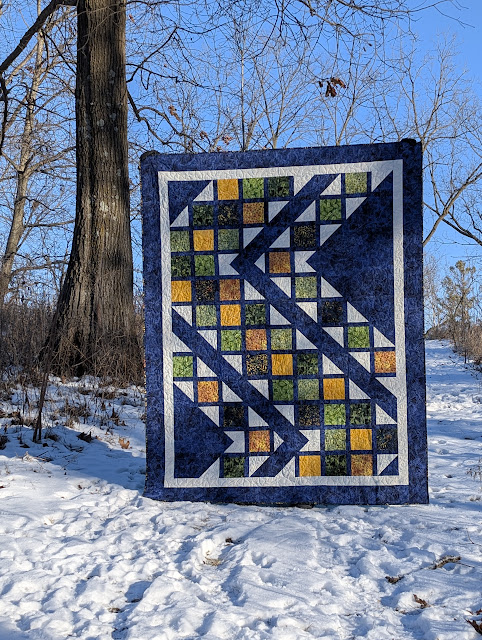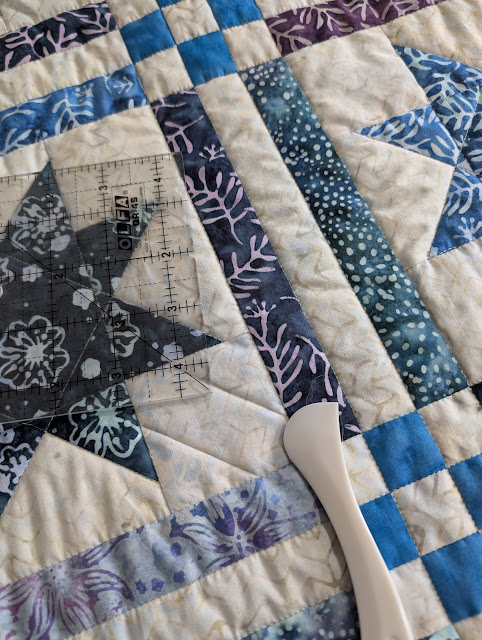For years I used the same fabric for binding a quilt as I used in the last border. It was a rule. I don't know where I heard it or saw it or who came up with it, but it was a rule and I followed it. Over the last few years I have pretty much thrown that "rule" out the window and started having fun with my binding choices.
Still, this weekend I chose to bind Patchwork Wishes in the same fabric as I used in the border.
Sewing binding on is pretty boring, so my mind tends to wander. This time it wandered and wondered if there was any pattern to my binding choices. When do I choose matchy-matchy and when do I chose a contrast? When I choose a contrasting binding, do I choose a reads-as-solid or a print?
I might have taken a small break to scroll through my quilt photos. Here are some trends I found in my quilts, complete with some brand new close-up photos of some bindings.
***********************
Quilts without borders
When the "border" matches the background, or if there is no border, I usually choose a contrasting binding to act as a frame.
Quilts with light borders
When a quilt has a light-colored borders, a darker binding adds a more solid edge to the quilt. It also will show dirt less than a light binding would.
Quilts with pieced borders
When there's a lot happening in borders already, as in the case of a pieced border, a contrasting border might be one extra detail too many. In the two quilts below, I used a matching binding to avoid pulling the eye away from the pretty pieced borders.
Quilts with prints in the border
I used fabrics that read more solid to corral the prints in the borders of these quilts.
Notice that Crossings also has a pieced inner border, so obviously the "matching binding when there's a pieced border" above is not a hard and fast rule!
Prints or Stripes for extra interest
Most of my quilts end up with a fairly plain binding, but every now and then the right print comes along to add a little pop.
Saling School also belongs in the "quilt with no borders" category, but repeating a print from the quilt really kicked the binding up a notch.
Stripes can be stricky. You need to find a striped print with colors that go really well with the fabrics in your quilt, but if you do, it can be really fun, like the diagonal stripe on Tic Tac Who - puppy version.
A print binding against a solid border can also work.
Repeating a border accent
Multiple borders with a binding that repeats the fabric from an inner border can emphasize the idea of the border as a frame. It reminds me of a picture frame with molding. You can see that in Focus Squared above, as well as in Starlight Plaid below.
Scrappy quilts and other quilts with scrappy bindings
With busy scrappy quilts, I can go either way: a quiet solid binding to contrast with the busy scrappy center, or a scrappy binding to embrace the scrappiness.
Quilter's scrapbook has a lot going on in the scrappy blocks, as well as the pieced border, so the red binding matching the border avoids adding one more element to the mix.
None of my pictures of scrappy quilts with scrappy bindings really show the binding well enough to illustrate. My Temperature quilt isn't technically a scrap quilt, but it does have a scrappy look and the scrappy binding repeating all the colors works really well.
 |
| Temp quilt back - because this is a better picture of the scrappy binding :) |
I also like to use up leftover strips if there are some several leftover after making a quilt top with precut 2 1/2" strips.
After all that analysis, you may wonder if I still use matching binding. I do. Not very often, but I do. Genrerally, I'll use binding that matches the border if there's a lot happening visually in the rest of the quilt and I feel it doesn't need to have yet another element stand out. That was the case for Patchwork Wishes which I bound this weekend.
 |
| Patchwork Wishes - pattern release coming soon! |
(Patchwork Wishes will get it's very own post soon! Stay tuned.)
Tell me about your binding choices. Do you have any guidelines you follow? Do you like your binding to fade into the background or pop with color? Any favourite successes or some you wish you had chosen differently?
Happpy quilting,
Joanne
PS: You can read about how I machine bind my quilts
here.





















































